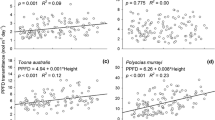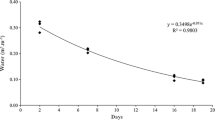Abstract
Crown exposure to light (CE) and tree allometry were investigated for 11 species in a snowy cool-temperate secondary forest dominated by Fagus crenata and Betula ermanii in Japan. The 11 species differentiated horizontal and vertical light gradients for regeneration. CE was highly variable across species in small trees, but variation in CE decreased with increasing height. The 11 species were classified into three patterns of height-dependent change in CE in comparison to community-level trends, and rank reversal of CE with increasing height was not apparent. Allometric relationships between trunk diameter (D) and height (H) and between D and trunk length (L) differed little between trees of high and low CE within species. In contrast, slopes of the allometric relationships between D and H differed across species; species with larger maximum height (H max) were taller at a given D, as was noted in previous studies of warm-temperate and tropical forest trees. Differences in trunk angle among the species of different H max were the main factor generating the differences in allometric relationships between D and H in this forest. Trunk angle increased with increasing height in the species of large H max but decreased in those of small H max. Hence, allometric relationships between D and L were not related to H max. Since the species of small H max grow laterally and are easily covered in snow during winter while those of large H max grow vertically above snow cover, differences in trunk angle may reflect species mechanical properties.






Similar content being viewed by others
References
Aiba S-I, Kohyama T (1996) Tree species stratification in relation to allometry and demography in a warm-temperate rain forest. J Ecol 84:207–218
Aiba S-I, Kohyama T (1997) Crown architecture and life-history traits of 14 tree species in a warm-temperate rain forest: significance of spatial heterogeneity. J Ecol 85:611–624
Aiba M, Nakashizuka T (2009) Architectural differences associated with adult stature and wood density in 30 temperate tree species. Funct Ecol 23:265–273
Bonser SP, Aarssen LW (1994) Plastic allometry in young sugar maple (Acer saccharum): adaptive responses to light availability. Am J Bot 81:400–406
Clark DA, Clark DB (1992) Life history diversity of canopy and emergent trees in a neotropical rain forest. Ecol Monogr 62:315–344
Clark DB, Clark DA, Rich PM (1993) Comparative analysis of microhabitat utilization by saplings of nine tree species in neotropical rain forest. Biotropica 25:397–407
Davies SJ, Palmiotto PA, Ashton PS, Lee HS, LaFrankie JV (1998) Comparative ecology of 11 sympatric species of Macaranga in Borneo: tree distribution in relation to horizontal and vertical resource heterogeneity. J Ecol 86:662–673
Falster DS, Warton DI, Wright IJ (2006) SMATR: Standardised Major Axis Tests & Routines
Homma K (1997) Effects of snow pressure on growth form and life history of tree species in Japanese beech forest. J Veg Sci:781–788
Horn HS (1971) The adaptive geometry of trees. Princeton University Press, Princeton
Ishii R, Higashi M (1997) Tree coexistence on a slope: an adaptive significance of trunk inclination. Proc R Soc Lond B 264:133–140
Kamitani T (1984) Studies on the process of formation of secondary beech forest in a heavy snowfall region (1) Bending of stems and its influence upon the stratification (in Japanese). Bull Niigata Univ For 17:1–16
King DA (1990) Allometry of saplings and understorey trees of a Panamanian forest. Funct Ecol 4:27–32
King DA (1994) Influence of light level on the growth and morphology of saplings in a Panamanian forest. Am J Bot 81:948–957
King DA (1996) Allometry and life history of tropical trees. J Trop Ecol 12:25–44
Kohyama T (1987) Significance of architecture and allometry in saplings. Funct Ecol 1:399–404
Kohyama T (1993) Size-structured tree populations in gap-dynamic forest—the forest architecture hypothesis for the stable coexistence of species. J Ecol 81:131–143
Kohyama T, Suzuki E, Partomihardjo T, Yamada T, Kubo T (2003) Tree species differentiation in growth, recruitment and allometry in relation to maximum height in a Bornean mixed dipterocarp forest. J Ecol 91:797–806
Kume A, Ino Y (1993) Comparison of ecophysiological responses to heavy snow in two varieties of Aucuba japonica with different areas of distribution. Ecol Res 8:111–121
Kume A, Ino Y (2000) Differences in shoot size and allometry between two evergreen broad-leaved shrubs, Aucuba japonica varieties in two contrasting snowfall habitats. J Plant Res 113:353–363
Kume A, Tanaka C (1996) Adaptation of stomatal response of Camellia rusticana to a heavy snowfall environment: winter drought and net photosynthesis. Ecol Res 11:207–216
Kume A, Tanaka C, Matsumoto S, Ino Y (1998) Physiological tolerance of Camellia rusticana leaves to heavy snowfall environments: the effects of prolonged snow cover on evergreen leaves. Ecol Res 13:117–124
Osada N (2011) Height-dependent changes in shoot structure and tree allometry in relation to maximum height in four deciduous tree species. Funct Ecol 25:777–786
Osada N, Tateno R, Hyodo F, Takeda H (2004) Changes in crown architecture with tree height in two deciduous tree species: developmental constraints or plastic response to the competition for light? For Ecol Manag 188:337–347
Poorter L, Werger MJA (1999) Light environment, sapling architecture, and leaf display in six rain forest tree species. Am J Bot 86:1464–1473
Poorter L, Bongers F, Sterck FJ, Woll H (2003) Architecture of 53 rain forest tree species differing in adult stature and shade tolerance. Ecology 84:602–608
Poorter L, Bongers F, Sterck FJ, Woll H (2005) Beyond the regeneration phase: differentiation of height-light trajectories among tropical tree species. J Ecol 93:256–267
Poorter L, Bongers L, Bongers F (2006) Architecture of 54 moist-forest tree species: traits, trade-offs, and functional groups. Ecology 87:1289–1301
Sheil D, Salim A, Chave J, Vanclay S, Hawthorne WD (2006) Illumination-size relationships of 109 coexisting tropical forest tree species. J Ecol 94:494–507
Sterck FJ, Clark DB, Clark DA, Bongers F (1999) Light fluctuations, crown traits, and response delays for tree saplings in a Costa Rican lowland rain forest. J Trop Ecol 15:83–95
Sterck FJ, Bongers F, Newbery DM (2001) Tree architecture in a Bornean lowland rain forest: intraspecific and interspecific patterns. Plant Ecol 153:279–292
Thomas SC (1996) Asymptotic height as a predictor of growth and allometric characteristics in Malaysian rain forest trees. Am J Bot 83:556–566
Turner IM (2001) The ecology of trees in the tropical rain forest. Cambridge University Press, Cambridge
Umeki K (1995) A comparison of crown asymmetry between Picea abies and Betula maximowicziana. Can J For Res 25:1876–1880
Young TP, Hubbell SP (1991) Crown asymmetry, treefalls, and repeat disturbance of broad-leaved forest gaps. Ecology 72:1464–1471
Young TP, Perkocha V (1994) Treefalls, crown asymmetry, and buttresses. J Ecol 82:319–324
Acknowledgments
I thank Kouki Hikosaka, Satoki Sakai, Koji Yonekura, and Naoko Tokuchi for their valuable suggestions. I also thank anonymous reviewers for their helpful comments on the manuscript. This study was partly supported by grants from the Ministry of Education, Science, Sports and Culture of Japan (18770011 and 21780140), and from the Nissan Foundation (08336).
Author information
Authors and Affiliations
Corresponding author
Electronic supplementary material
Below is the link to the electronic supplementary material.
Rights and permissions
About this article
Cite this article
Osada, N. Crown exposure to light and tree allometry of 11 tree species in a snowy cool-temperate forest in Japan. Plant Ecol 213, 783–794 (2012). https://doi.org/10.1007/s11258-012-0041-5
Received:
Accepted:
Published:
Issue Date:
DOI: https://doi.org/10.1007/s11258-012-0041-5




